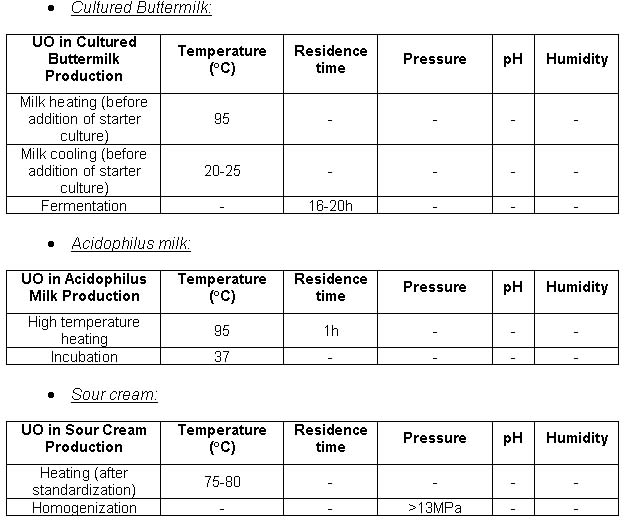Other fermented milk products
From Efficiency Finder
Back to Information about milk products
I. GENERAL DESCRIPTION:
- 1. Definition
- (Dairy science and Technology, University of Guelph, http://www.foodsci.uoguelph.ca/dairyedu/home.html)
- Cultured buttermilk: This product was originally the fermented by-product of butter manufacture, but today it is more common to produce cultured buttermilks from skim or whole milk. The culture most frequently used in S. lactis, perhaps also spp. cremoris. This product is frequently used as an ingredient in the baking industry, in addition to being packaged for sale in the retail trade.
- Condensed buttermilk: It can be evaporated on its own or it can be blended with skim-milk and dried to produce skim-milk powder. This blended product may oxidise readily due to the higher fat content. Condensed buttermilk is perishable and, therefore, the supply must be fresh and it must be stored cool.
- Acidophilus milk: Acidophilus milk is a traditional milk fermented with Lactobacillus acidophilus (LA), which has been thought to have therapeutic benefits in the gastrointestinal tract.
- Another variation has been the introduction of a sweet acidophilus milk, one in which the LA culture has been added but there has been no incubation. It is thought that the culture will reach the GI tract where its therapeutic effects will be realized, but the milk has no fermented qualities, thus delivering the benefits without the high acidity and flavour, considered undesirable by some people.
- Sour cream: Cultured cream usually has a fat content between 12-30%, depending on the required properties. The starter is similar to that used for cultured buttermilk.
- Condensed whey: In the process of cheese-making, there is a lot of whey that needs to be disposed of. One of the ways of utilizing cheese-whey is to condense it. The whey contains fat, lactose, ß -lactoglobulin, alpha-lactalbumin, and water. The fat is generally removed by centrifugation and churned as whey cream or used in ice cream. Evaporation is the first step in producing whey powder.
- Whey powder: Whey powder is essentially produced by the same method as other milk powders. Reverse osmosis can be used to partially concentrate the whey prior to vacuum evaporation. Before the whey concentrate is spray dried, lactose crystallization is induced to decrease the hygroscopicity. This is accomplished by quick cooling in flash coolers after evaporation. Crystallization continues in agitated tanks for 4-24h. A fluidized bed may be used to produce large agglomerated particles with free-flowing, non-hygroscopic, no caking characteristics.
- Converting whey into powder has led to a number products that it can be incorporated into. It is most desirable, if and where possible, to use it for human food, as it contains a small but valuable protein component. It is also feasible to use it as animal feed. Between the pet food industry and animal feed mixers, hundred's of millions of pounds are sold every year. The feed industry may be the largest consumer of dried whey and whey products.
- Whey proteins concentrates: Both whey disposal problems and high-quality animal protein shortages have increased world-wide interest in whey protein concentrates. After clarification and pasteurization, the whey is cooled and held to stabilize the calcium phosphate complex, which later decreases membrane fouling. The whey is commonly processed using ultrafiltration, although reverse osmosis, microfiltration, and demineralization methods can be used. During ultrafiltration, the low molecular weight compounds such as lactose, minerals, vitamins and nonprotein nitrogen are removed in the permeate while the proteins become concentrated in the retentate. After ultrafiltration, the retentate is pasteurized, may be evaporated, then dried. Drying, usually spray drying, is done at lower temperatures than for milk in order that large amounts of protein denaturation may be avoided.
- Others: There are a great many other fermented dairy products, including kefir, koumiss, beverages based on bulgaricus or bifidus strains, labneh, and a host of others. Many of these have developed in regional areas and, depending on the starter organisms used, have various flavours, textures, and components from the fermentation process, such as gas or ethanol.
- 2. General Flowsheet
Not available.
- 3. Description of techniques, methods and equipment
- (Dairy science and Technology, University of Guelph, http://www.foodsci.uoguelph.ca/dairyedu/home.html)
- Cultured Buttermilk: Milk is usually heated to 95°C and cooled to 20-25°C before the addition of the starter culture. Starter is added at 1-2% and the fermentation is allowed to proceed for 16-20 hours, to an acidity of 0.9% lactic acid.
- Acidophilus milk: Skim or whole milk may be used. The milk is heated to high temperature, e.g., 95°C for 1 hour, to reduce the microbial load and favour the slow growing LA culture. Milk is inoculated at a level of 2-5% and incubated at 37°C until coagulated. Some acidophilus milk has an acidity as high as 1% lactic acid, but for therapeutic purposes 0.6-0.7% is more common.
- Sour cream: The cream after standardization is usually heated to 75-80°C and is homogenized at >13MPa to improve the texture. Inoculation and fermentation conditions are also similar to those for cultured buttermilk, but the fermentation is stopped at an acidity of 0.6%.
- 4. Temperature ranges and other parameters
- (Dairy science and Technology, University of Guelph, http://www.foodsci.uoguelph.ca/dairyedu/home.html)
- 5. Benchmark data
Not available.
II. NEW TECHNOLOGIES:
See information for dairies.
III. SOLAR SYSTEMS INTEGRATION:
Heat treatment in all cases requires a maximum temperature of 95°C and is easily reachable by using solar systems. Due to the fact that large amounts of hot water or steam may be required, auxiliary boilers can be used additionally to solar collectors (Joanneum Research).
Back to Information about milk products
